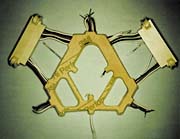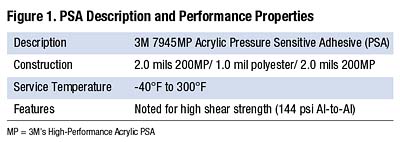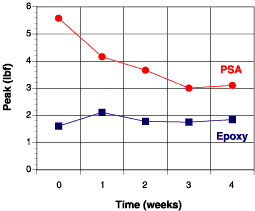
A device design was being changed. Part of the change was to ask key suppliers to lower the costs of components they supplied to us. We also wanted to work in partnership with them to improve device performance and reduce costs to produce.
Our wire-harness supplier for the device was approached for cost improvements. The supplier came back to us with a couple of options. One has been tested and incorporated, and the other is soon to be incorporated into our device build.
The wire harness is a urethane potting/encapsulation allowing multiple wires to be harnessed (permanently placed) in the positions needed for the device application. The wire-harness manufacturer proposed an alternate process that would improve material usage, labor and overall part cost.
For the first process change, the urethane potting material (Hysol US4028) remained the same with only the amount of potting reduced and little change to the bonding surface. The harness manufacturer made this change via a new mold and potting process. The resulting wire harness encapsulated and sufficiently held together the multiple wires to lower the overall amount of potting material and the cost for material and labor.
The wire-harness surface contour changed only very slightly. The flat-bonding surface of the wire harness now has some periodic holes, which were a result of the wire-holding tabs placed in the mold to keep the wires secure during the potting operation.
The change in wire harness allowed us the opportunity to suggest a change in adhesive. Since the wire-harness change would require qualification testing with some additional adhesive testing, we could incorporate improved processing at the assembly operation.
The current process of attaching the wire harness to the Laser Block Assembly (LBA) was via nine small strips of pre-form epoxy, which had to be cut by the operators and kept frozen for storage. The epoxy also was limited to a six-month frozen shelf life.
Handling the epoxy was difficult. It needed to be kept frozen almost up to the moment of application to the LBA, which made for some timing and hand-skill challenges for the operators.
The operators learned to work with epoxy pre-form over the years by using cold sinks and working quickly since the epoxy becomes a paste when it is not frozen. The cold sinks are frozen pieces of steel placed on the operators' benches; the epoxy strips are placed on the steel to keep them cold and workable for ease of cutting, liner removal and placement onto the LBA bond areas.
The pieces of epoxy also needed to be placed as accurately as possible on the same nine places of the LBA each time so they would not affect the performance of the device. The epoxy pre-form needed to be heat-cured under pressure, which also allowed the adhesive to flow and potentially change placement.
Hence, the epoxy pre-form was difficult to work with. It was inconsistent for placement and required pressure fixtures for heat curing, which hindered our output improvements when trying to attain increased production rates. The cure time, oven usage and quantity of fixtures particularly hindered production rates. The epoxy pre-form also caused reworks because of material and process inconsistencies, which would be detected during device testing.

Criteria for Adhesive Selection
The cost initiatives and qualification of a new wire harness gave us the perfect opportunity to suggest a different adhesive that would be easier to use, simpler to bond and more consistent than the epoxy pre-form. The application of the wire harness to the glass block did not require very high shear strength (which the epoxy pre-form provided). Rather, the forces are more in peel due to the dithering motions applied to the device, pulling the wire harness off of the glass block. Hence, the wire-harness adhesion component bends slightly. A stiff, rigid epoxy could have a tendency to pull the glass block with the wire harness when in motion.The motion, in conjunction with the backing's (wire harness) stiffness/modulus over the application-temperature ranges
(-65 deg. F to 200 deg. F), played an important part in the screening criteria. Similarity also was a factor in the selection criteria of a new adhesive based on other operations at our facility.
The best adhesives for peel strength are pressure sensitive adhesives (PSAs). A PSA previously had been selected for another application on a similar device manufactured at our facility, as well as for an application where a silicone low-modulus adhesive had been used. These other applications made the change to a PSA on the wire harness less risky, since it was qualified for these applications via temperature cycling and adhesion testing and had been performing well on the device applications.
The substrates differed in the applications; so screening adhesion testing needed to be conducted. The wire-harness application where the PSA was being used was on a KaptonR wire harness with approximately half the bond area and weight.
The other application of the PSA was a replacement for a two-part, addition-cure silicone adhesive. The silicone adhesive was another difficult material when it came to handling, contamination, shelf life, bond time and fixturing. The application was for bonding a painted magnetic shield to a chromated aluminum housing. The application was a wonderful success, resulting in improved adhesion, processing time and application ease.
In the case of the urethane wire harness, the PSA now needed to bond to a high-energy glass and a medium-energy urethane surface. The application required a PSA that was high in peel and shear strength, and performed over the application and device testing temperatures. It also needed to meet the chemical resistance needs of the post wire-harness install build processes, where solder flux, soldering and solvent cleaning (isopropyl alcohol) operations were performed.

Conclusion
A PSA supplied by the 3M Company met the demands of the urethane wire-harness application. Its properties are shown in Figure 1 and its peel adhesion vs. epoxy in Figure 2.The PSA improved assembly operation and reduced costs. We purchase the wire harness with the PSA die-cut and pre-applied to the wire harness (see photo on page 44). The assembly operation involves removing the PSA liner, aligning the wire harness in a fixture, applying pressure with the fixture clamp and then removing the bonded assembly from the fixture and moving it onto the next operation in the device build.
Changing the adhesive to a PSA saves process time and labor costs and improves device performance because the PSA is easier to use, simplifies the assembly operation, and improves the consistency of performance and the application.
Additional information on 3M 7945MP pressure sensitive laminating adhesive is available from 3M Engineered Adhesives Division, St. Paul, Minn., by calling 1-800-362-3550 or visiting the Web site www.mmm.com/adhesives. Or Circle No. 74.